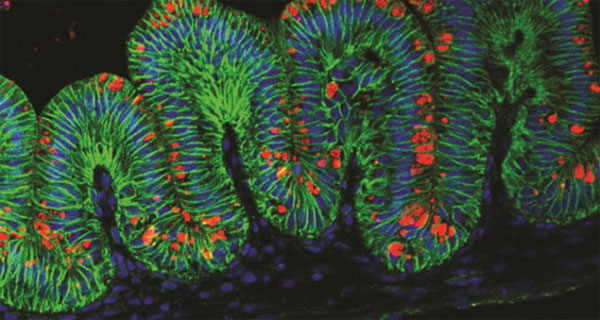Create the stomach in the world's first laboratory
Scientists on October 29 said they created the first "mini stomach" in the world, which could be helpful for cancer studies, stomach ulcers and diabetes.
>>> Simulation stomach helps to study digestion
This "mini-stomach" is actually tissue consisting of many cell shoots as "miniature version of the stomach".
In the journal Nature, researchers say they are made of modified pluripotent stem cells to grow into stomach cells.

Human stomach tissues (marked in green) are made from pluripotent stem cells - (Photo: AP)
Initial tests on mice showed that they could be used as "patches" of gaps caused by duodenal ulcers. They also marked an important step in how to stimulate stem cells to become 3D structures.
Scientists say 'mini stomach' also facilitates studies of diseases such as cancer, diabetes and obesity, thereby helping to find new drugs to treat the disease.
It can also pave the way for preventing stomach cancer, even one day that will help create an artificial stomach instead.
Jim Wells, a researcher at the Cincinnati Children's Hospital Medical Center (Ohio, USA), says scientists now use animals to study human disease.
However, this solution is not optimal with the stomach due to the structure and biology of the stomach of very different animal stomachs.
Therefore, creating a "simulated" stomach stomach will help them a lot.
- Good diet for stomach sick people
- How should people with stomach pain eat and drink on New Year's Day?
- Metaplace: Virtual world for everyone
- Stomach cancer is detected through breathing
- Create supernova explosions in the laboratory
- Things to pay attention to patients with stomach pain
- Stress - The culprit in stomach disease
- Australia can feed on heart tissue
- Stomach Meter
- 6 good food for the stomach
- China first built an underwater laboratory
- 4-year-old baby pregnant in the stomach
 Why is Australia the country with the highest cancer rate in the world while Vietnam ranks 100th?
Why is Australia the country with the highest cancer rate in the world while Vietnam ranks 100th? New drug causes cancer to 'starve'
New drug causes cancer to 'starve' Common cancers in men
Common cancers in men America's incredible discovery: The most feared cancer cell is love
America's incredible discovery: The most feared cancer cell is love How big can the human stomach expand?
How big can the human stomach expand?  Does eating spicy food really cause stomach ulcers?
Does eating spicy food really cause stomach ulcers?  Daily habits that can cause stomach pain
Daily habits that can cause stomach pain  Pea helps reduce stomach pain
Pea helps reduce stomach pain  The cancer-causing HP virus has become twice as difficult to kill
The cancer-causing HP virus has become twice as difficult to kill  The 5 best mushrooms to prevent type 1 carcinogens, make kids smarter
The 5 best mushrooms to prevent type 1 carcinogens, make kids smarter 